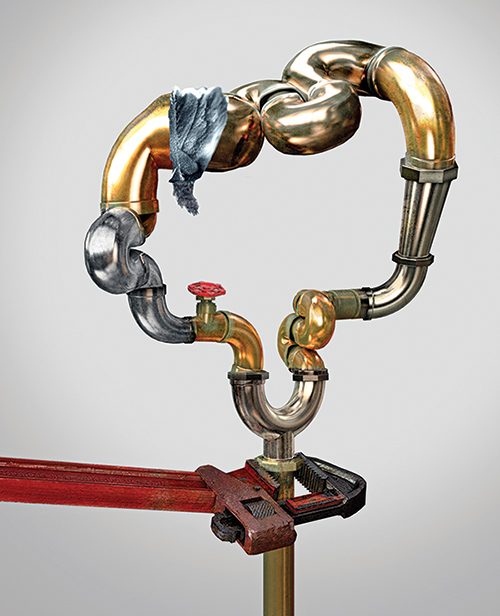The Health Screening You Must Have
With early diagnosis and treatment of colon cancer, thousands of lives could be saved

Tall, lean Steffi Wessa of Landau, Germany, had never had a serious illness, so when in late 2013, after she turned 55, her physician suggested they add a routine colorectal cancer screening by colonoscopy to her regular medical check-up, Steffi had no reason for concern.
Colorectal cancer (CRC), often called colon cancer, is a malignancy in the large intestine, that twisty tube through which waste products exit the anus. The last six or so inches of colon are called the rectum.
During the colonoscopy—examination of the entire colon with an endoscope—the doctor found two polyps, benign growths in the intestinal wall that have the potential to turn cancerous if left untreated. These the doctor removed during the procedure. But there was something more: a five-centimeter growth in the rectal area. It appeared to be a carcinoma.
A biopsy confirmed the physician’s suspicions: Steffi had colorectal cancer. On hearing the news, Steffi was distraught. “My world collapsed. To me, cancer meant death.”
Steffi was just one of approximately 447,000 Europeans to be diagnosed with colon cancer that year, and the numbers are increasing annually. Globally, CRC is the third most common of all cancers, and in continental Europe it is the second most common malignancy, after breast cancer which has about 464,000 annual diagnoses. It’s also the second most deadly, killing about 215,000 Europeans every year.
But it needn’t be a killer. Colorectal cancer, when discovered in its early stages, is one of the most treatable cancers. And Steffi’s had been caught early, before it could spread.
What puts us at risk of getting colon cancer in the first place? The risk increases with age—those older than 50 make up the vast majority of cases—but it can strike much younger people as well.
“There can be genetic factors, environmental factors, or an interplay between the two,” says Dr. Jordan Karlitz, MD, FACG, associate professor of gastroenterology at Tulane University School of Medicine in New Orleans, Louisiana. He notes that ulcerative colitis and Crohn’s disease can lead to the development of CRC if the illness afflicts a significant portion of the colon. A sedentary lifestyle adds to the risk.
The modern diet and lifestyle are believed to be among the most significant risk factors. A diet heavy on meat, especially processed meats, and light on fruits, vegetables and fiber, can predispose someone to CRC, as can smoking tobacco and drinking alcohol, says Dr. Luc Colemont, a Belgian gastroenterologist and managing director of the foundation Stop Colon Cancer. People who are obese or who have type two diabetes have a heightened risk as well.
A study published in January this year, whose lead author was Dr. Shuji Ogino, professor of pathology at Harvard University, suggests one reason why diet might affect your CRC risk. When we eat we are feeding the trillions of micro-organisms that live in our intestines. And if those well-fed micro-organisms are of the troublesome kind, they might pay you back by making you sick. CRC tumor tissue often hosts a nasty germ called fusobacterium nucleatum. The study found that people who ate a fiber-rich, healthful diet tended to have lower levels of these bacteria, as well as lower risk of CRC influenced by the bacteria.
But known risk factors still can’t account for all cases of CRC. “I saw people, 56 years of age, not overweight, never smoked, only a beer on the weekend, every day healthy food, and three times a week in fitness,” says Dr. Colemont. “But they have colon cancer.”
And doctors have recently reported an alarming rise in the incidence of colorectal cancer in people younger than 50—even among those in their 20s and 30s—which is why it’s crucial to see your doctor if you have any symptoms, even if they seem insignificant.
Early detection is the key to beating colon cancer. Every expert Reader’s Digest spoke to stressed the importance of screening for CRC. Screening “could potentially save more than half of the people who are dying from colorectal cancer,” says Dr. Karlitz. That’s a potential of more than 100,000 lives saved per year in Europe alone.
There are several types of screening, including a fecal test, a CT scan, a sigmoidoscopy and a colonoscopy.
Possibly the most common/readily accessible in Europe is the fecal test. It’s both simple and inexpensive. You get a kit from the doctor, follow the at-home directions for collecting a stool sample, and ship everything back. These tests look for blood in the sample that isn’t apparent to the naked eye. A positive result may be evidence of either pre-cancerous polyps or of cancer.
A positive result is usually followed by a colonoscopy, a test typically repeated every ten years. The individual fecal test can be less accurate than a colonoscopy, but because fecal tests are done more often, the likelihood of detection increases with each successive test.
A sigmoidoscopy, although similar to a colonoscopy, is not as extensive. In this procedure, the last 40 or so centimeters of the colon, plus the rectum, are examined by endoscope. Typically it is repeated every five years. Another, less common screening method is CT colonography—essentially a CAT scan of the colon. And a test using a pill-sized camera that is swallowed and videos the lining of the colon is available in a number of countries for those who can’t undergo colonoscopy.
But colonoscopy is considered the gold standard of screening. It can discover more abnormalities than any other screening test. It can detect more pre-cancerous polyps, and at an earlier stage, than fecal tests. That’s important because finding and removing polyps during colonoscopy can prevent about 80 percent of colon cancers, according to a 2012 study. That same report noted that, when people at average risk for getting colon cancer were screened via colonoscopy, the incidence of the disease fell by 67 percent and deaths were reduced by 65 percent.
But colonoscopy is an invasive procedure and it can be difficult to persuade people to get screened this way. When physicians in The Netherlands were seeking to increase screening participation, they sent out invitations to members of the population 50 and older, offering a variety of screening options. When the invitations yielded more than twice the number of participants for fecal tests than colonoscopies, that’s where The Netherlands focused its efforts. Today, the country has the highest rate of CRC screening in Europe. In Britain, too, a fecal test kit is sent every two years to everyone over 60 who is registered with a GP. In France, fecal tests kits are sent to everyone age 50 and older.
Screening rates vary dramatically by country—or even within the same country—but, on average, fewer than half of adults in Europe age 50 and older currently get tested for colorectal cancer.
Now 58, Steffi Wessa can attest to the value of screening. She might not be alive today without it. After her cancer was detected, she was treated with chemotherapy and radiation, which shrank the tumor, then surgery to remove it. Now cancer-free, she gets regular check-ups to ensure she stays that way.
Once you notice symptoms of CRC, putting off screening can be a bad decision. In early 2013, Belgian Filip Luypaert, 44, was focused on his career as a high-powered executive for an international medical device company. In great physical condition, he had no known risks for cancer. But he’d recently noticed blood in his stool. When he mentioned this to his GP, the doctor recommended a sigmoidoscopy, just as a precaution.
“I was running twice a week, ten kilometers, traveling around the globe for work,” Filip recalls. At his age and condition, neither he nor his doctor seriously believed he could have colorectal cancer.
So Filip put off screening for another six months, expecting the symptoms to pass. When he finally had a full colonoscopy in October 2013 it revealed that Filip had colorectal cancer. The tumor was too large to remove right away. Worse, further testing determined that the cancer had spread to his liver.
Filip searched the internet for survival rates in stage four CRC. The best case scenarios gave him only an 11 to 12 percent chance of surviving five more years.
He’d had so many plans. His girlfriend was in the process of emigrating from Singapore to be with him. How could he now ask her to leave behind her family, her professional life—everything—when he probably wouldn’t be alive for much longer?
If a tumor is too large to remove immediately, surgery will be necessary to cut away the diseased section of the colon. “In some countries, 50, 60, 70 percent of colon cancer surgery can be done by laparoscopic surgery,” says Dr. Colemont. This less radical type of operation involves smaller incisions than traditional “open” surgery, and often translates to faster healing.
Over five days’ time, Filip was given the equivalent of five weeks worth of radiation to shrink his main tumor enough so it could eventually be removed. Then came three months of chemotherapy, followed by surgery to remove the diseased section of his colon. At that point, to give his wound time to heal, surgeons redirected waste products from his lower colon to a stoma, a temporary opening in his abdomen. After another three months of chemo, it was time to operate on his liver. That was followed by more chemo.
It was almost exactly a year from the time of diagnosis to Filip’s last chemotherapy treatment. “I just had to live one day at a time, and that was, for me, very difficult, and especially to see the people around me suffering from my uncertainty and pain.”
After several setbacks, including two more surgeries to remove additional metastases on and near his liver, Filip finally got the news he’d been hoping for. At his last check-up, doctors found no trace of cancer.
And in April 2016 he ran again for the first time since his ordeal began, in a 10 kilometer race in Antwerp. His girlfriend plans to join him in Belgium.
Even if you’ve had colorectal cancer, there are steps you can take to mitigate the risk of your cancer recurring. Live a healthier lifestyle, of course, and maintain a healthy weight. But just as low-dose aspirin has been shown to reduce the risk of heart attack, it may reduce the risk of colorectal cancer, including hereditary forms. Dr. Colemont says that among people who take low-dose aspirin, “It seems that they have a lower recurrence rate than the people who don’t take it.”
It also may reduce the risk of dying of the disease if you’ve been diagnosed with CRC, according to a 2015 research report. And while no European associations have yet recommended aspirin for prevention in healthy people, the US Preventive Services Task Force came out in favor of a daily low-dose aspirin for certain people 50 to 59 years old, but only those who are not at risk for increased bleeding, and who can commit to taking it for ten years.
Vitamin D might also play a role in prevention, although the link isn’t proven. “We have population studies showing that of patients who have lower vitamin D levels, they have a higher rate of colon cancers,” says Dr. Grothey.
According to the US National Institutes of Health, two randomized controlled trials suggest that 1,200 to 2,000 milligrams of calcium per day may reduce the risk of polyps recurring. The American College of Gastroenterology recommends supplements to colorectal cancer survivors.
But the best way to lower your risk is to stay vigilant. If you are over age 50 and have never had CRC and have no symptoms, talk to your doctor about screening. Those who have had CRC or are at risk for getting it should be screened more often than the general population. And if you experience any of the symptoms associated with the disease, even if they seem mild and inconsequential, tell your doctor. Your life could depend on it.
Colorectal Cancer Symptoms
Colorectal cancer symptoms are often subtle and easily ignored. But if you have any of the following symptoms lasting for two or more weeks, it’s imperative that you talk to your physician about getting tested:
- Blood in stool or rectal bleeding
- Changes in your bowel habits
- Stool that is narrower than typical for you
- Unusual weakness or fatigue
- Weight loss for no apparent reason
- Feeling that your bowel isn’t emptying completely after a bowel movement
- Digestive pains (bloating, gas, cramps)
- Vomiting
- Diarrhea or constipation



